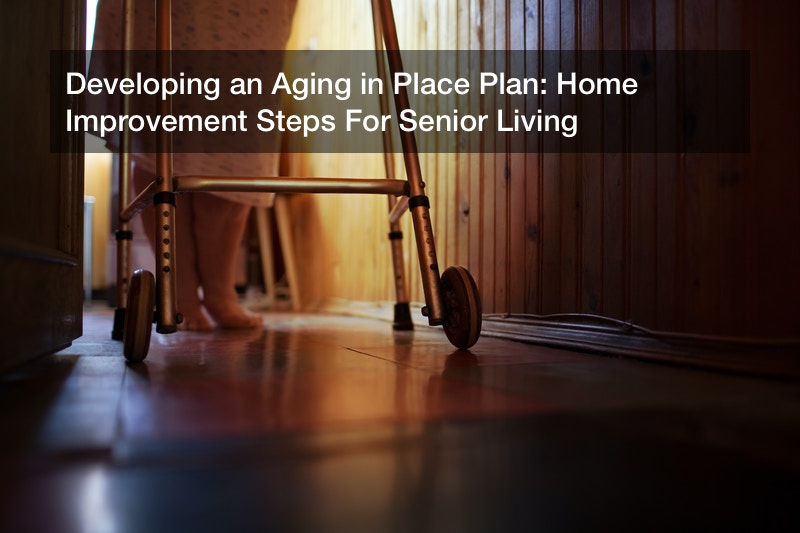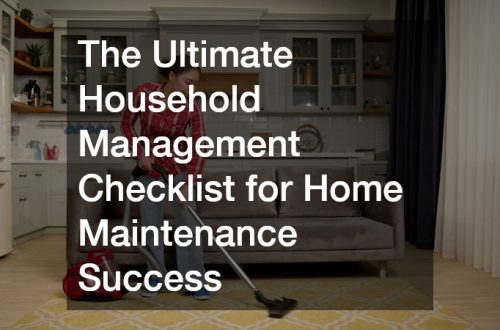
When it comes to senior living arrangements, many aging Americans hope to be able to stay in their own homes. Known as “aging in place,” this practice has many benefits that make it an appealing prospect. However, not all homes are accessibility-ready — and for many, it can be difficult to continue living independently without the right types of assistance. To help you better understand all of your options, here is what you need to know about creating your own aging in place plan.

Types of Senior Living Options
- Senior Housing Communities: Moving into a senior living community prior to needing assisted living or nursing care can allow seniors to hold onto their independence. While you will still have your own home, you will no longer have to worry about yard work, maintenance, or snow removal, as all of this will be included. A 55 and older community will also often have many amenities close to home. These can include fitness centers, adult education classes, dining, and entertainment. Furthermore, you will be surrounded by neighbors closer to your age who will have similar interests. This makes socialization easier, which can help boost mood and mental wellbeing. Although this option does require moving into a new home, because it’s catered towards aging Americans, it can make continuing to live on your own easier.
- Downsizing to a Smaller Home: If your current home is too large, it can cause problems down the line — especially if you have mobility issues. While residential lifts can make it easier to get up and downstairs, even the task of cleaning a large house can be too much. For this reason, many Americans looking to create aging in place plans consider downsizing. Downsizing can make living independently more manageable as it cuts down on housekeeping and the work it takes to simply get around. Smaller homes can also be safer for those with mobility issues as there will be fewer obstacles that could potentially contribute to slips or falls. Downsizing can also allow you to focus more on the things you want to do, instead of constantly worrying about upkeep. Additionally, if improvements are needed to make it more accessible, you will need much less work done than if you still had a larger home. It’s worth taking a look at a new home for sale around you to see if any would be a better fit for you.
- Staying in Your Current Home: Staying in your current home is also an option and is one that many seniors prefer. When it comes to creating an aging in place plan, many seniors are more comfortable staying in the home they know best. While this can require adjustments and improvements in some areas, you’ll be able to remain in the place you love most. Staying in your own home can also mean staying closer to friends and family who can positively impact mental well-being. If additional assistance is needed, in-home care providers, landscaping services, or housekeepers can be employed to help lift the burden of maintaining everything on your own. Because of helpful options like these, many seniors are opting to stay in their current homes. Many seniors have done this successfully for years.
Before creating your own aging in place plan, these three options are something to seriously consider to see which would be best for you. If you already live in a smaller home, for instance, downsizing may not be needed. Instead, you may choose to focus on improving your current home to be more accessible. Similarly, you may like the idea of living in a community that caters to you, making senior housing a more enticing option. Regardless of which option you choose, aging in place can be a beneficial choice for many seniors and it is something that should be seriously thought about if you are close to turning 65.

The Benefits of Aging in Place
Now that we’ve talked about housing options, let’s take a closer look at why having an aging in place plan is beneficial.
Aging in place allows seniors to stay in an environment where they feel most comfortable. This can help prevent unnecessary stress and mental strain that may arise from moving into an unfamiliar senior living facility. While assisted living programs are great for those who need additional care, they may feel too clinical or crowded for those who wish to retain as much of their independence as possible. If additional help is needed, in-home care services can be employed to help with medications or basic tasks. Because of the influx of services like this, more and more seniors are capable of living in their own homes for much longer.
Staying in your own home can also be a healthier option, as you won’t be living in a facility with groups of other residents. This can help cut down on the spread of illnesses, a problem that has become more emphasized in recent months. The stress of moving to a new location can also put seniors at risk as it can negatively affect the immune system impacting physical health and quality of life.
Another benefit is the ability to retain routines and be close to friends and family. This allows seniors to continue doing the things they normally would, while also giving them access to a support network that helps maintain mental health. While assisted living facilities can provide socialization, trying to make new friends after an already stressful move can be difficult and this can often lead to feelings of isolation. Staying at home can prevent this and allow for current relationships to be better maintained.
This interaction, coupled with the familiar surroundings, can also help prevent cognitive decline and memory problems. This is because familiar sights, sounds, and smells can trigger more powerful memories and make it easier to recall things. Staying in your own home has been shown to help slow the decrease of cognitive functions even in the early stages of Alzheimer’s. However, in some dementia cases, it’s important to consider the need for memory care services — even if they won’t be needed immediately.

Aging in Place Safely
If you are creating your own aging in place plan, it’s important to consider the improvements you can make in your home to improve your quality of life as you age. Out of 90% of seniors looking to stay in their homes for the next five to 10 years, 85% are confident that they can remain without significant modifications. However, as you age, it can be difficult to know what supports you’ll need in the coming years, and even if your certain you won’t need any accommodations, all it takes is one slip and fall to change everything. Because of this, you should consider taking steps to improve your current home to suit your future needs, not just those you need right now. Here are some improvements to consider.
- Grab Bars: Installing grab bars in high-risk areas such as the bathroom and bedroom can help with those experiencing mobility issues. Bars near the shower, toilet, and bed can help prevent slips and falls, especially in slippery areas. If you currently have a step-out tub, these can be especially helpful as you get older, as they can help provide sturdy support when shifting out of a slippery tub. With nearly 80% of all falls occur in the bathroom, this is a must-have for many aging in place plan.
- Outdoor Ramps: While lift chairs can be used to help navigate stairs inside your home, any outdoor steps can still pose a risk. Installing a ramp isn’t just beneficial for those in wheelchairs, but it can help those with knee problems who might otherwise experience pain walking up the stairs. You might also consider installing anti-slip matting on the ramp to further decrease the risk of slips, especially if the ramp is something you will be using frequently.
- Faucets: Touchless faucets in the bathroom and kitchen can make it easier for those struggling with arthritis and other grip issues. You can also invest in anti-scald faucets that help prevent blasts of hot water when a toilet is flushed or the cold water is otherwise prevented. This can prevent burns and also potential falls caused by jerk reactions while showering.
- Home Lighting: Adding extra home lighting in otherwise dark spaces such as hallways or bathrooms can also help prevent trips and falls. Undercounter lights in the kitchens and nightlights can help make getting around the house at night easier and much safer. Similarly, installing a heat lamp in the bathroom can help make it more comfortable during the winter, especially if it takes you longer to take care of everything you need to do in the bathroom.
- Door Knobs: Similar to replacing turn faucets, replacing traditional doorknobs with lever style ones can make it easier for seniors to get in and out of rooms.
- Counter Tops: Lowered countertops aren’t only good for those in wheelchairs, but they can make getting around in the kitchen much easier. Updating countertop material to something easier to clean can also be beneficial. For instance, installing lowered granite counter tops can help with both access and housekeeping. Lowering your cabinets is also an idea to consider, especially if you already struggle to reach things on higher shelves. Instead of putting yourself at risk by using a step stool, consider having them lowered, or moving the things you use most to more accessible heights. This can help ensure that you can continue using your kitchen as normally as possible.
- Smart Technology: Smart technology has helped improve the lives of many seniors and it is something to consider in your aging in place plan. Technology like medical alerts, a home security system, and remote monitoring can all help keep seniors safe in their own homes. Similarly, wearable alert systems such as necklaces and bracelets can also help in the event of a fall. You can also get shoe inserts that work in tandem with doorway sensors that can alert an emergency service if the sensor detects someone entering a room but not exiting within a specified time frame. Pressure-sensitive mats placed next to beds and sensors in medicine cabinets can also help alert family members to you getting out of bed or taking your medication at a designated time. This can be beneficial especially if you have trouble remembering to take specific medications. If the sensor isn’t tripped at the appropriate time, a family member can call and give you a reminder.
- Landscaping: Landscaping is a great way to add visual appeal to your home and also create a relaxing space to enjoy. Consider hiring a professional landscaper to remove any safety hazards, while also creating a relaxing space to spend your evenings. While not necessarily a big change, having a relaxing and safe outdoor space and help boost mood and give you an excuse to get outdoors.
- Widened Doorways: If your current doorways are less than 32 inches wide, you may want to consider widening them so that they can accommodate a mobility device or wheelchair. While you may not need them now, it’s a good thing to have a plan for, especially if you already are experiencing mobility problems.
- Slip-Resistant Flooring: Replacing flooring with linoleum or vinyl options can also help prevent dangerous slips and falls due to them providing more traction than other options. Materials like this are also softer and can be more forgiving should a fall actually occur. Harder materials and carpeted floors can be accidents waiting to happen, and replacing them should be a priority in your aging in place plan if they are prevalent in your home.

Prepare for the Future
One of the most important things to keep in mind when creating your aging in place plan is that you’re not necessarily planning for the here and now. Instead, you are planning for the next 10 to 20 years. While you might not necessarily be experiencing many mobility issues at age 65, by the time you reach 75, this could change dramatically. Consider the areas of your home that might pose difficulty in the future and take steps to help make your home both accessible and safe.
Aging in place is a wonderful thing to begin considering if you are reaching the age of 65. Keep in mind the different options available to you, as well as the changes to your home that may be the most useful. While putting together your aging in place plan may take time, it will be well worth it in the end.





